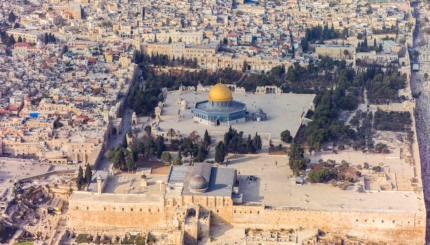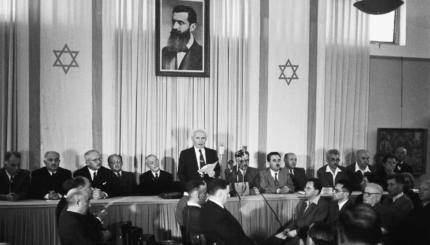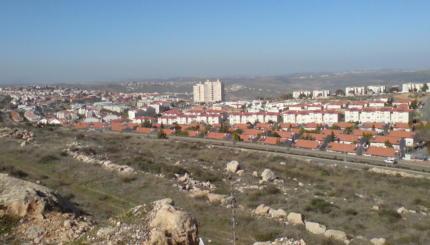Jordan signed a peace treaty with Israel in 1994, but the resulting peace is lukewarm at best. Popular opinion in Jordan is resentful of the Jewish state for its treatment of the Palestinians. Jordan’s monarchy cannot afford to ignore popular opinion, so it tries to strike a balance between its own strategic interests–namely good relations with its often-quarrelling neighbors–while accommodating the wishes of its majority Palestinian population and the rising tide of Islamic fundamentalism.

King Hussein I
“Jordan is stuck between Iraq and a hard place,” its ruler King Abdullah II likes to quip, reflecting on the conflicting pressures Jordan’s warring neighbors exert. In order to understand Jordan’s dilemma vis-à-vis Israel, it is important to understand the kingdom’s history.
An Expanding Kingdom
In 1921, at a time when vast amounts of Middle East real-estate were up for grabs, Winston Churchill appointed Abdullah bin al-Hussein, the son of an Arab nobleman, as Arab governor of the eastern part of the Palestine Mandate, an area called Transjordan. The British gave Abdullah independence over this region in 1946, and the kingdom of Transjordan was born.
Abdullah was a relatively pro-Western and moderate Arab leader, expressing admiration for the technical know-how of Zionist settlers in western Palestine. Nevertheless, in 1947, when the United Nations decided to partition Palestine into a Jewish and Arab state, King Abdullah couldn’t resist the chance to enlarge his kingdom. He seized on the chaos of the ensuing war to conquer what is now known as the West Bank.

Help us keep Jewish knowledge accessible to millions of people around the world.
Your donation to My Jewish Learning fuels endless journeys of Jewish discovery. With your help, My Jewish Learning can continue to provide nonstop opportunities for learning, connection and growth.
After the war, Transjordan became Jordan, and Abdullah found himself ruling several hundred thousand Palestinians there, both the original Arab inhabitants of the West Bank, and refugees from Israel who settled along the Jordan River.
Syria, Egypt, and Iraq became worried about Jordanian aggrandizement, and they smeared Abdullah in their government-controlled press, describing Israel and Jordan as “allies” and accusing Abdullah of betraying the Palestinians by entering into somewhat tepid peace talks with the Zionists.
On July 20, 1951, Abdullah was visiting the Al Aqsa Mosque in Jerusalem with his grandson Prince Hussein when he was shot dead by a Palestinian nationalist who was reportedly afraid Abdullah would make peace with the Israelis. Hussein, who was also shot, survived and ascended the throne in 1952 at the age of 17.
King Hussein, the Palestinians, and Israel
King Hussein may have well concluded from this that the Palestinians posed the greatest danger of all to his kingdom. He worked diligently to suppress a Palestinian national identity, repeatedly stating that “Jordan is Palestine and Palestine is Jordan,” a phrase now cited approvingly by the Israeli right.
From the 1950s through the 1970s, Hussein was a staunch ally of the United States, receiving millions of dollars in aid and information from U.S. intelligence. But with the onset of the Six Day War in 1967, King Hussein was swept up in the anti-Israel fervor, making what he later termed “the biggest mistake of my life” by launching mortars against Israel.
In the Six Day War, Israel captured the West Bank and East Jerusalem from Jordan. Approximately 300,000 Palestinian refugees from these regions fled to the territory on the east side of the Jordan, and the Palestinian population under Hussein’s rule grew even more.
Nationalistic feelings among Palestinians living in Jordan rose, leading to open conflict with the Jordanian state. 1n 1970, following a series of hijackings orchestrated by the Palestine Liberation Organization, King Hussein violently confronted the PLO, leaving several thousand Palestinians dead in what became known as “Black September.”
Throughout his reign, King Hussein maintained regular contacts with Israeli leaders–who also had an interest in suppressing Palestinian nationalism. During Black September, when a Syrian invasion of Jordan became likely, Israel deployed troops on its own northeast border, causing Syrian leader Hafez al Assad to back down.
But despite Israel and Jordan’s cooperation, the two countries did not sign a peace treaty until 1994. King Hussein repeatedly said that he could not go further than the Palestinians; he simply could not openly be closer to Israel than his majority Palestinian population. Only once Yasser Arafat had signed the Oslo Accords in 1993, did Hussein have the political cover he needed to make official what had been a tacit alliance for decades.
A Lukewarm Peace
But there has never been the kind of “normalization” between Jordan and Israel that one would expect of two countries at peace. As with the Oslo Accords, the Jordan-Israel peace treaty was expected to lead to phenomenal economic benefits, as the two nations would beat their swords into productive activity and Israeli hi-tech would complement Jordanian low-wage labor. Indeed, Jordanian business elites entered into mutually beneficial partnership with their Israeli counterparts, who exported low-wage textile jobs to Jordan, where labor costs were competitive with the world’s poorest countries.

King Hussein, PM Rabin, President Clinton
But ordinary Jordanians have not yet reaped the economic fruits of peace. One of the negative effects of bilateral Jordanian-Israeli trade, and the opening of a free trade agreement with the U.S., has been raising prices due to the increased productivity of only a small sector of the population. This is one way the peace treaty is between Israel and the Jordanian elite, for their own commercial benefit and for the sake of the U.S., not the majority of Jordanians.
In light of this, with more than half of Jordan’s population identifying as Palestinian, every deterioration in Israel’s relationship with the Palestinians has stirred up negative feelings in Jordan. Thus, when Benjamin Netanyahu opened the Hasmonean Tunnel in Jerusalem at the end of September 1996, Palestinians living in Jordan perceived it as an affront to their honor, and this led to violence in Jordan.
The attempted poisoning of Khalid Mashal, the head of Hamas’ political bureau in Amman by Mossad agents in 1997, also stirred up anger against Israel among Palestinians in Jordan, with King Hussein only preserving the peace treaty because Israel released Hamas leader Ahmed Yassin from prison.
King Abdullah II’s ascension to the throne in 1999 led to further deterioration of the relationship between Israel and Jordan. The Second Intifada and Israel’s military operations in Gaza halted many joint economic and cultural ventures. In spring 2010, King Abdullah II said that the relationship between the two countries was at its worst in years, and Jordan was better off economically before the 1994 treaty. King Abdullah II openly expressed his support for a “Palestinian state on Palestinian soil,” a departure from his father and grandfather’s position vis-à-vis Israel. Although Jordan does not show any intentions of reneging on the 1994 peace treaty with Israel, the “warm peace” of 1994 has cooled.


